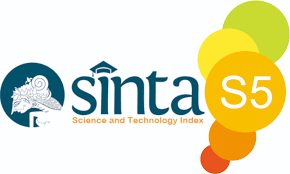Kualitas Cake Dengan Variasi Tape Ketan Hitam (Oryza sativa var. glutinosa) Menggunakan Pewarna Bunga Telang (Clitoria ternatea L.)
(1) Universitas Atma Jaya Yogyakarta
(2) Universitas Atma Jaya Yogyakarta
(3) Universitas Atma Jaya Yogyakarta
(*) Corresponding Author
Abstract
Black sticky rice is potential food which can be used to source bioactive compounds, carbohydrate, antioxidant, and fiber. Activity of active compounds and nutrition which contained in food ingredient it can increase with fermentation. Black sticky tapai which has sour flavor it less liked by most people, so it needs to be processed by making cakes. This research purpose is to know the effect variation of wheat flour and black sticky tapai, and to know the best variation of wheat flour and black sticky tapai to physical, chemical, microbiological, and organoleptic. The research using different concentration of black sticky tapai, there are K (0:1), A (1:1), B (1:2), and C (1:3), and colorant of butterfly pea flower using the same concentration. The best result of this research is cake with concentration B (1:2). Result showed that cake with concentration B (1:2) was contained 33,00 % water content, 1,37 % ash content, 19,72 % fat content, 7,70 % proteins content, 38,43 % carbohydrate content, 0,48 mg GAE/g phenolics content, 24,62 % antioxidant content, 158 g texture analysis, cake has white color, 5,20 log CFU/g total plate count, and 3,23 log CFU/g yeast molds.
Keywords
Full Text:
PDFReferences
Adam, M. R., and Nout, M. J. 2001. Fermentation and Food Safety. Aspen Publiser Inc., Maryland.
Aldwin. 2018. Kualitas muffin menggunakan tepung ubi jalar (Ipomoea batatas) dan tepung kecambah kacang tunggak (Vigna unguiculata). Diakses http://e-journal.uajy.ac.id/14231/ pada tanggal 20 Februari 2020.
Aligita, W. 2007. Isolasi antosianin dari ketan hitam (Oryza sativa L. Forma Glutinosa). Skripsi. Institut Teknologi Bandung, Bandung.
Avila, M., Hidalgo, M., Moreno, C. S., Pelaez, C., Requena, T., dan de-Pascuel, T. S. 2009. Bioconversion of anthocyanin glycosides by bifidobacteria and lactobacillus. Food Research International 42:1453-1461.
Ghiselli, A., Nardini, M., Baldi, A., dan Scaccini, C. 1998. Antioxidant activity of different phenolic fractions separated from an italian red wine. Journal of Agricultural and Food Chemistry 46(2):361-367.
Iljas, B. M. 2001. Pengaruh penggunaan brem dari tape ketan (Oryza sativa glutinosa) terhadap umur simpan cake (bolu) brem. Skripsi. Fakultas Teknologi Pertanian, Institut Pertanian Bogor, Bogor.
Kadirantau, D. M. E. 2000. Kajian isothermi sorpsi air (ISA) dan stabilitas tepung ketan selama penyimpanan. Skripsi. Institut Pertanian Bogor, Bogor.
Kazuma, K., Noda, N., and Suzuki, M. 2003. Flavonoid composition related to petal color in different lines of Clitoria ternatea. Phytochemistry 64(6):1133-1139.
Kusuma, R. 2008. Pengaruh penggunaan cengkeh (Syzygium aromaticum) dan kayu manis (Cinammomum) sebagai pengawet alami terhadap daya simpan roti manis. Skripsi. IPB, Bogor.
Lee, M. P., Abdullah, R., dan Hung, K. L. 2011. Thermal Degradation of Blue Anthocyanin Extract of Clitoria ternatea Flower. International Conference on Biotechnology and Food Science IPCBEE. 7:49-53.
Lukman, A., Anggraini, D., Rahmawati, N., dan Suhaeni, N. 2013. Pembuatan dan uji sifat fisikokimia pati beras ketan kam¬par yang dipragelatinasi. Jurnal Peneli¬tian Farmasi Indonesia 1(2):67-71.
Marpaung, A. M. 2012. Optimasi proses ekstraksi antosianin pada bunga telang (Clitoria ternatea L.) dengan metode permukaan tanggap. Tesis. Bogor (ID): Institut Pertanian Bogor.
Muchtadi, T. R., dan Subarna. 1991. Teknologi Pengolahan Pangan Nabati. Fateta-IPB, Bogor.
Parves, S., Malik, K. A., Kang, S. Ah., dan Kim, H. Y. 2006. Probiotics and their fermented food products are beneficial for health. Journal of Applied Microbiology 100:1171-1185.
Pasukamonset, P., Pumalee, T., Sanguansuk, N., Chumyen, C., Wongvasu, P., Adisakwattana, S., and Ngamukote, S. 2018. Physicochemical, antioxidant and sensory characteristics of sponge cakes fortified with Clitoria ternatea extract. J. Food Sci. Technol. https://doi.org/10.1007/s13197-018-3204-0 diakses pada tanggal 27 Mei 2020.
Pietta, P. G. 2000. Flavonoids as antioxidants. Journal of Natural Products 63(7):1035-1042.
Rahman, A. 1992. Teknologi Fermentasi. Arcan, Bandung.
Sitanggang, A. B. 2017. Faktor kerusakan produk bakteri dan pengendaliannya. Food Review 12(2):40-44.
Subeki. 1998. Pengaruh cara pemasakan terhadap kandungan antioksidan beberapa macam sayuran serta daya serap dan retensinya pada tikus percobaan. Thesis. Institut Pertanian Bogor, Bogor.
Suhartatik, N. 2014. Potensi bakteri asam laktat indigenous dalam degradasi enzimatik antosianin beras ketan (Oryza sativa var. glutinosa) hitam. Disertasi. Fakultas Pasca Sarjana, Universitas Gadjah Mada, Yogaykarta.
Tarwotjo, S. 2008. Dasar-dasar Gizi Kuliner. Grasindo, Jakarta.
Vankar, P. S., dan Srivastava, J. 2010. Evaluation of Anthocyanin Content in Red and Blue Flowers. International Journal of Food Engineering 6(4):1-11.
Winarno, F. G. 1997. Kimia Pangan dan Gizi. Gramedia, Jakarta.
Article Metrics
Abstract view : 1133 timesPDF - 604 times
DOI: https://doi.org/10.26714/jpg.10.2.2020.1-11
Refbacks
- There are currently no refbacks.
Copyright (c) 2020 Jurnal Pangan dan Gizi
 | Jurnal Pangan dan Gizi |

This work is licensed under a Creative Commons Attribution-NonCommercial-NoDerivatives 4.0 International License.












